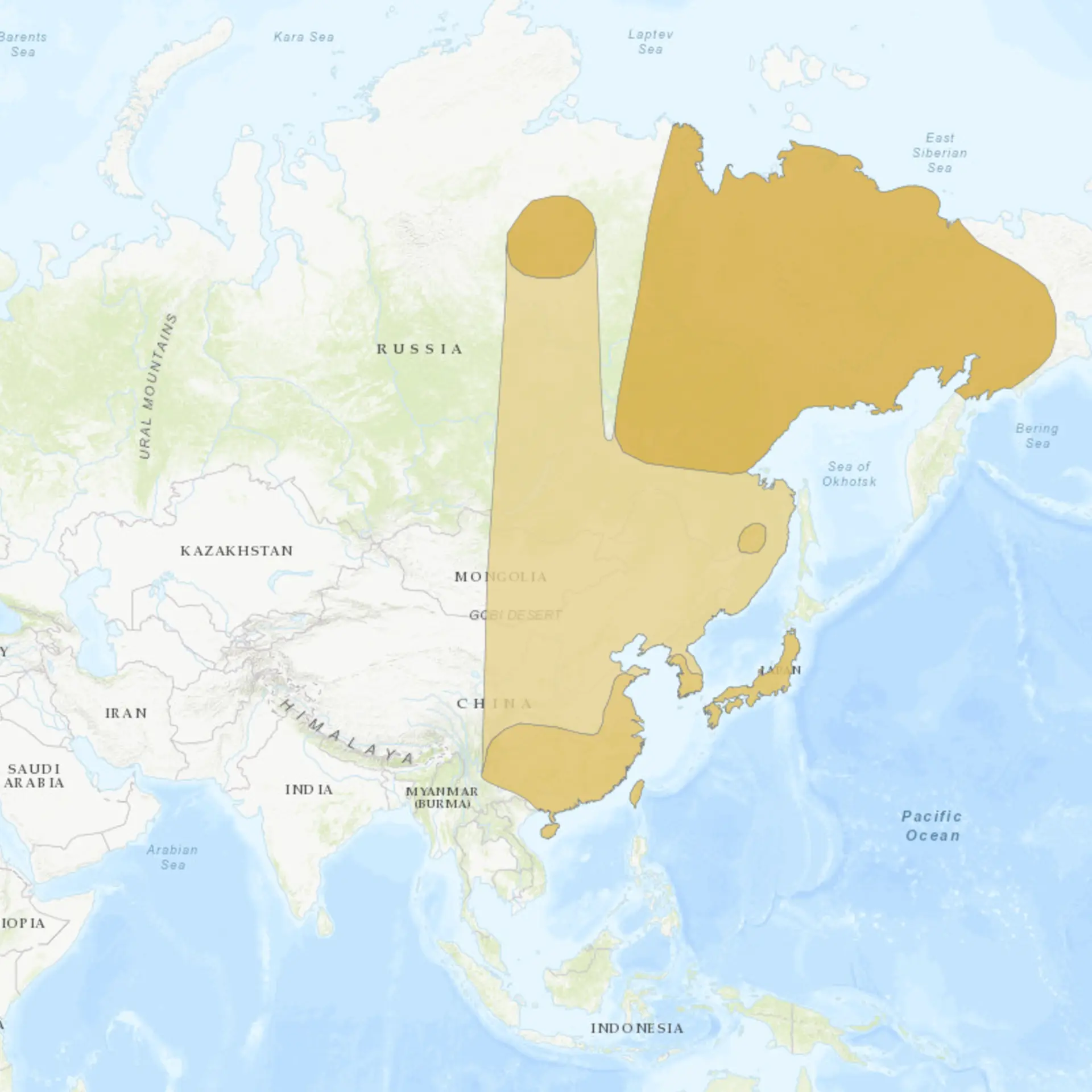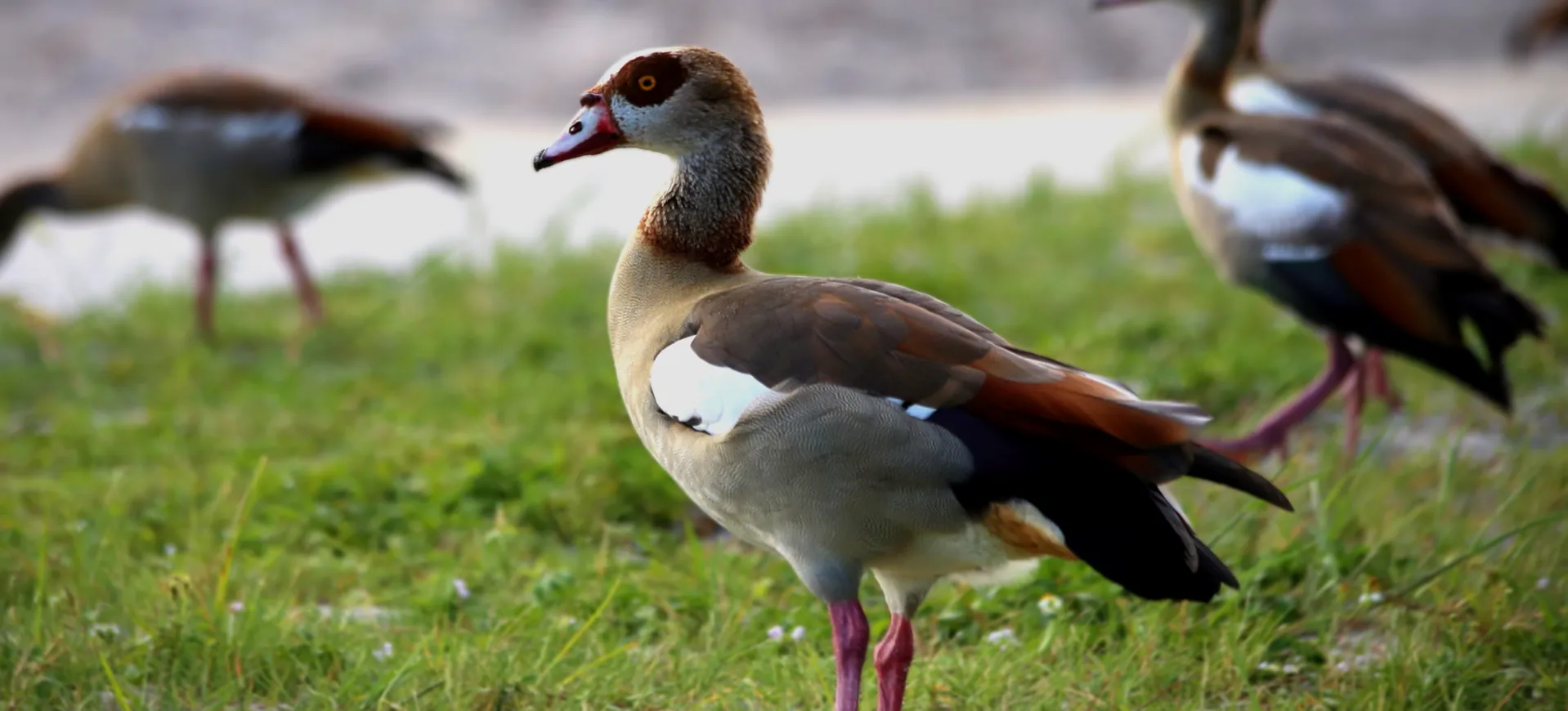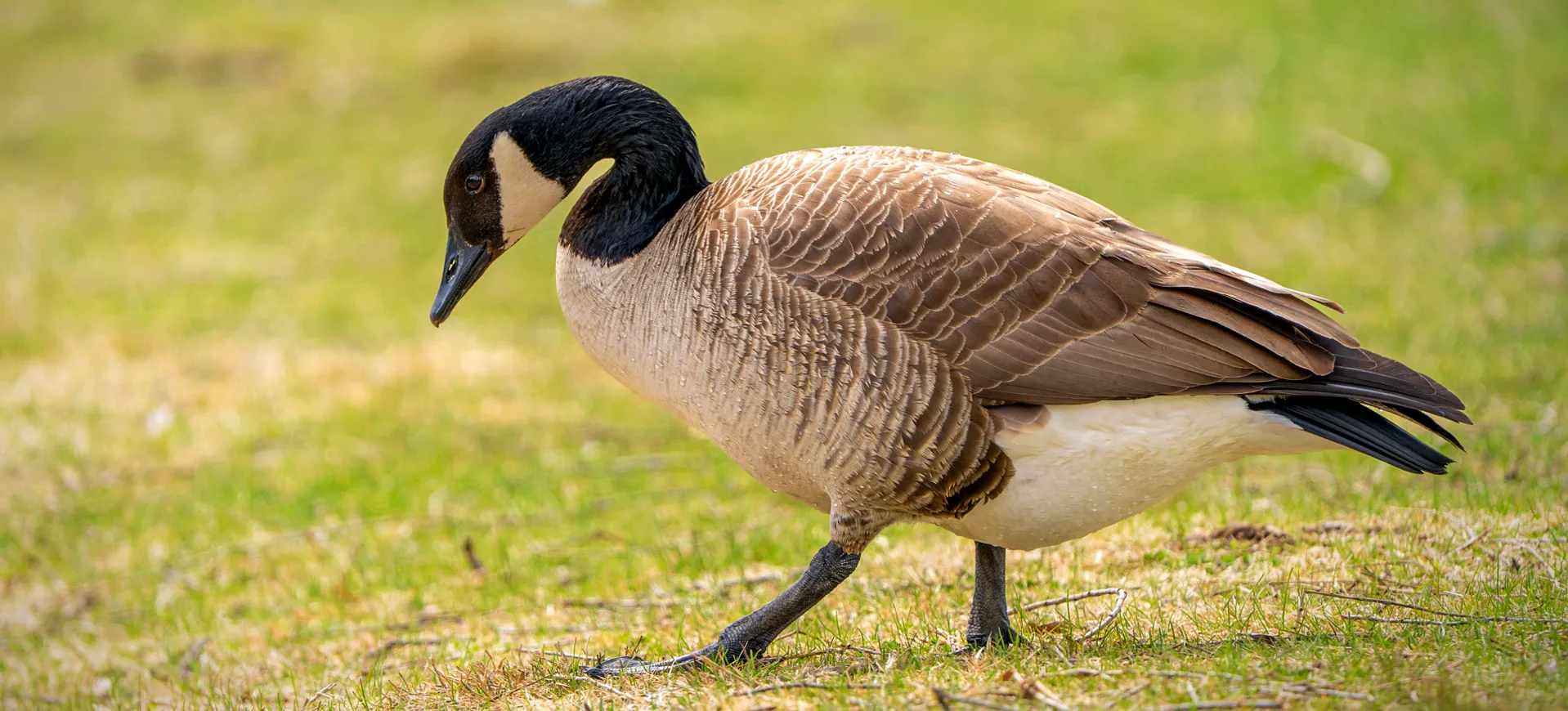Overview
The Baikal Teal, known scientifically as Sibirionetta Formosa, is a small dabbling duck with distinctive and striking plumage. Males in breeding plumage display a unique head pattern with a green nape, a circular white patch on each side of the head, and a spotted chestnut breast, setting them apart from other waterfowl. Females and non-breeding males are more subdued in coloration, featuring mottled brown plumage that provides excellent camouflage in their natural wetland habitats. These ducks are highly sociable during the non-breeding season, forming large flocks that can number in the thousands, showcasing their remarkable ability for synchronized flight and collective feeding.
The Baikal Teal is native to Eastern Asia, primarily breeding in Siberia and Russia and wintering in warmer regions of South Korea, Japan, and parts of China. Their preferred habitats include shallow freshwater wetlands, lakes, and marshes, where they can find abundant aquatic plants and invertebrates to feed on. Despite facing threats from habitat loss and hunting, concerted conservation efforts have helped stabilize some populations, reflecting the species’ resilience and the success of international wetland protection measures. The Baikal Teal’s migration patterns are a subject of ongoing study, offering insights into the ecological health of wetlands across Asia.
Conservation efforts for the Baikal Teal include international cooperation to protect critical habitats along their migratory routes. These efforts are supported by organizations such as the East Asian-Australasian Flyway Partnership, which ensures the survival of migratory waterbirds. The species indicates the health of wetland ecosystems, with their presence signaling a well-functioning habitat. Despite these positive steps, the Baikal Teal remains at risk from environmental pollution, climate change, and the continuation of habitat destruction, necessitating ongoing vigilance and conservation action.
Taxonomy
Kingdom
Phylum
Class
Order
Family
Genus
Species
Type
Current distribution:
Today, the Baikal Teal can be found across its native range in Siberia during the breeding season and in various parts of East Asia during the winter. While their numbers have fluctuated historically, recent conservation efforts have led to an increase in some populations. Creating protected wetlands and international cooperation to preserve critical migratory stopover sites have been key to this success. However, the species still faces challenges due to habitat loss and degradation, especially in their wintering grounds.
The presence of Baikal Taels in non-breeding areas, such as South Korea and Japan, is a highlight for birdwatchers and conservationists. It indicates the health of wetland habitats in these regions. Their adaptation to various wetland types, from natural marshes to man-made rice paddies, showcases their resilience and the importance of diverse aquatic ecosystems for migratory birds. Ongoing research and monitoring are essential to understanding their distribution to the fullest extent and implementing effective conservation strategies to ensure the Baikal Teal's continued recovery and preservation.
Physical Description:
In breeding plumage, the male Baikal Teal boasts a striking appearance with a pronounced circular white patch on each side of its head, a green nape, and a speckled brown and black body. The intricate patterns and vibrant colors of the male’s feathers serve not only to attract mates but also as camouflage in the dappled light of their aquatic habitats. Females and juveniles are less conspicuously colored, with a more uniform mottled brown appearance that provides excellent camouflage among reeds and vegetation. Both sexes have a compact body, a short neck, and a relatively small bill suited to their feeding habits of dabbling and sifting in shallow waters.
Outside the breeding season, males molt into a non-breeding plumage that more closely resembles the females, allowing them to blend into their surroundings and evade predators. The Baikal Teal’s wings are marked with a distinctive green speculum bordered by white, visible in flight and serving as a key identification feature. Despite their small size, Baikal Teals are hardy birds, capable of long migratory flights and quick maneuvers to escape predators. Their physical adaptations, including webbed feet for efficient swimming and a specialized bill for filtering food, highlight their evolution as successful freshwater dabblers.

Lifespan: Wild: ~10 Years || Captivity: ~15 Years

Weight: Male & Female: 0.9-1.3 lbs (400-600 g)

Length: Male & Female: 14-16 in (35-40 cm)

Wingspan: Male & Female: 24-28 in (60-70 cm)

Top Speed: 50 mph (80 km/h)
Characteristic:
Native Habitat:
The Baikal Teal is indigenous to Siberia’s boreal forests and wetlands, where it breeds in dense, marshy areas rich in aquatic vegetation. These habitats provide the seclusion and resources necessary for nesting and raising their young. The birds require fresh water for feeding and nesting, making the preservation of clean, unpolluted wetlands crucial for their survival. During the breeding season, they prefer locations that offer a combination of open water and dense cover, which protects them from predators and provides ample feeding opportunities.
The migration of Baikal Teals to their wintering grounds in South Korea, Japan, and parts of China is an impressive journey that spans thousands of miles. These winter habitats typically consist of coastal estuaries, rice paddies, and freshwater lakes, providing the teals with abundant food and relatively mild conditions. The conservation of these wintering areas is as important as the protection of breeding grounds, as the species’ survival depends on the availability of suitable habitats throughout their migratory route. International conservation agreements and initiatives are crucial in safeguarding the wetlands vital to the Baikal Teal’s lifecycle.
Climate Zones:
Biomes:
WWF Biomes:
Biogeographical Realms:
Continents:
Countries:
Diet:
Diet & Feeding Habits:
Baikal Teals are omnivorous, with a diet that includes various aquatic plants, seeds, and small invertebrates. They feed by dabbling at the water’s surface rather than diving, using their bill to filter food from mud and water. In the breeding season, their diet shifts to include more protein-rich invertebrates, which are crucial for egg production and the growth of young ducklings. During winter, when they migrate to warmer climates, Baikal Teals often feed in agricultural fields, consuming leftover grains and seeds, which supplement their natural diet and help them build reserves for the return migration.
The feeding habits of Baikal Teals play a significant role in the ecosystem, contributing to the control of aquatic invertebrates and the dispersal of plant seeds. Their preference for shallow wetlands encourages them to forage where their feeding activity can aerate the water and assist in nutrient redistribution. Conservation efforts that focus on protecting and restoring wetland habitats indirectly support the Baikal Teal’s food sources, ensuring the availability of diverse and abundant feeding grounds. The adaptability of their diet allows Baikal Teals to thrive in various habitats, although they remain dependent on the preservation of wetlands for their survival.
Mating Behavior:
Mating Description:
Baikal Teals form monogamous pairs during the breeding season, with males engaging in elaborate displays to attract females. These displays include vocal calls, feather displays, and mock fights with other males, all aimed at demonstrating their suitability as mates. Once paired, both the male and female participate in selecting a nesting site, usually on the ground in dense vegetation near water. The female then lays a clutch of 6 to 9 eggs, which she incubates for about 24 to 29 days, relying on the camouflage of her plumage to remain hidden from predators.
The male Baikal Teal remains near the nesting site during incubation, providing protection and occasionally participating in foraging. After the ducklings hatch, they are precocial, able to leave the nest within a day and begin feeding under the supervision of the female. The family unit remains together for several weeks, with the young ducklings learning to feed and fly under the guidance of their parents. This period of parental care is crucial for the survival of the ducklings, as it prepares them for the challenges of migration and independence.
Reproduction Season:
Birth Type:
Pregnancy Duration:
Female Name:
Male Name:
Baby Name:
Social Structure Description:
During the breeding season, Baikal Teals exhibit a strong pair bond, with males and females forming monogamous relationships essential for successful reproduction. The pair works together to select a nesting site and raise their offspring, demonstrating high parental care. Outside the breeding season, Baikal Teals become highly gregarious, forming large flocks including thousands of individuals. These flocks exhibit remarkable coordination, especially during migration, highlighting the importance of social interactions for the species’ survival.
The social structure of the Baikal Teal facilitates efficient foraging and predator avoidance, with individuals benefiting from the collective vigilance of the flock. Mixed-species flocks are common in wintering grounds, allowing Baikal Teals to interact with other waterfowl, sharing resources and habitats. Understanding the social dynamics of Baikal Teals is crucial for conservation planning, as it influences their habitat requirements and behaviors. Protecting the communal roosting and feeding areas is as important as preserving individual nesting sites, ensuring the species can maintain its complex social structure throughout the year.
Groups:
Conservation Status:
Population Trend:
The global population of Baikal Teals has shown signs of recovery in recent years, thanks in part to concerted conservation efforts and international cooperation. Despite this positive trend, the species remains vulnerable to habitat loss, environmental pollution, and the effects of climate change, which can quickly reverse gains made in its population numbers. Protecting the wetlands essential to its lifecycle, from breeding to wintering grounds, is key to its continued survival. Efforts to reduce hunting pressure and manage wetland habitats sustainably are also crucial for maintaining healthy populations.
In areas where wetland restoration has been prioritized, Baikal Teals have demonstrated a remarkable ability to rebound, highlighting the effectiveness of habitat conservation and management practices. Education and awareness programs have reduced hunting pressures in some regions, further supporting population recovery. The Baikal Teal’s status as a species of least concern does not diminish the importance of ongoing conservation work, as fluctuations in their numbers reflect the health of wetland ecosystems across their range.
Population Threats:
Habitat loss due to agricultural expansion, urban development, and wetland drainage is the most significant threat to the Baikal Teal. Pollution from agricultural runoff, industrial waste, and oil spills further degrades their habitats, affecting the quality of the water and food availability. Hunting and trapping, particularly along migration routes, continue to pose risks despite international regulations aimed at protecting migratory bird species. Climate change introduces additional challenges, potentially altering migratory patterns, breeding schedules, and the distribution of wetland habitats.
Conservation initiatives that address these threats include habitat protection and restoration projects, stricter enforcement of hunting regulations, and international agreements that protect migratory birds. Public education campaigns to reduce pollution and promote wetland conservation are also vital for the Baikal Teal’s survival. Collaborative efforts across the species’ range are essential to mitigating these threats’ impacts and ensuring the Baikal Teal’s long-term conservation.
Conservation Efforts:
Conservation efforts for the Baikal Teal are multifaceted, focusing on habitat protection, sustainable management of wetland areas, and international cooperation to safeguard migratory routes. Protected areas and nature reserves have been established in key breeding and wintering grounds, providing sanctuaries where the teals can thrive. Efforts to restore degraded wetlands and create new habitats have successfully supported population growth. International treaties, such as the Ramsar Convention on Wetlands and the Convention on Migratory Species, play a critical role in the global conservation of the Baikal Teal, facilitating cooperation between countries to protect shared natural heritage.
Education and community involvement are integral to conservation success, promoting stewardship of wetland habitats and reducing human impacts on the species. Research and monitoring programs provide valuable data on population trends, health, and habitat use, informing conservation strategies and management decisions. The collaboration between governments, conservation organizations, and local communities underscores the global commitment to preserving the Baikal Teal and the wetland ecosystems upon which they and countless other species depend. Continued investment in conservation and research is essential to ensure the Baikal Teal remains a symbol of wild wetland biodiversity.
Additional Resources:
Fun Facts
- The Baikal Teal is named after Lake Baikal in Siberia, though it does not exclusively inhabit this area.
- They can take rapid takeoffs, a defensive adaptation that helps them evade predators.
- The distinctive circular white patch on the male’s head has led to the nickname “spectacled teal.”
- Baikal Teals use a variety of vocalizations to communicate, especially during mating and migration.
- They are known for their spectacular mass takeoffs, where thousands of birds can ascend simultaneously, creating an impressive display.
- Despite their small size, Baikal Teals undertake long migratory journeys, demonstrating remarkable endurance.
- The species has shown a capacity for rapid population recovery under the right conservation conditions.
- Baikal Teals can sleep with one eye open, allowing them to rest while remaining vigilant for predators.
- They have been recorded in large flocks of up to 200,000 individuals during migration, showcasing their ability to gather in staggering numbers in suitable habitats.
- The Baikal Teal plays a crucial role in wetland ecosystems, contributing to the control of insect populations and the dispersal of aquatic plant seeds.



















































































